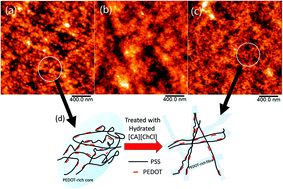Biocompatible, flexible and conductive polymers prepared by biomass-derived ionic liquid treatment†
Abstract
Poly(3,4-ethylenedioxythiophene):poly(styrenesulfonate) (PEDOT:PSS) is a promising, biocompatible conductive polymer for bio-integrated electronics with health-care applications. However, the intrinsic biocompatibility of PEDOT:PSS is potentially jeopardized by additives or post-treatment with toxic ionic liquids used to enhance electrical conductivity. In this work, a biomass-derived ionic liquid ([CA][ChCl]) based on citric acid and choline chloride was employed as an effective conductivity enhancer. Conductivities of 1320 S cm−1 were achieved by post-treatment with this ionic liquid. Hydrated-[CA][ChCl]-induced changes in the structure and electronic properties of PEDOT:PSS as observed by XRD, XPS, FTIR-ATR, UV-vis NIR, RAMAN spectroscopy, AFM and cyclic voltammetry. This characterization indicated more effective phase segregation between PEDOT and PSS, removal of PSS and a morphological change from core–shell grains to more interconnected fibres with concomitant improvement of electrical conductivity, flexibility, hydrophobicity and environmental stability. Hydration of the post-treatment reagent [CA][ChCl] to a mole fraction of 0.57 resulted in much reduced viscosity and greater efficacy. These results demonstrate hydrated biomass-derived ionic liquids be an effective biocompatible alternative to conventional post-treatments for the development of wearable PEDOT:PSS health-care devices.



 Please wait while we load your content...
Please wait while we load your content...